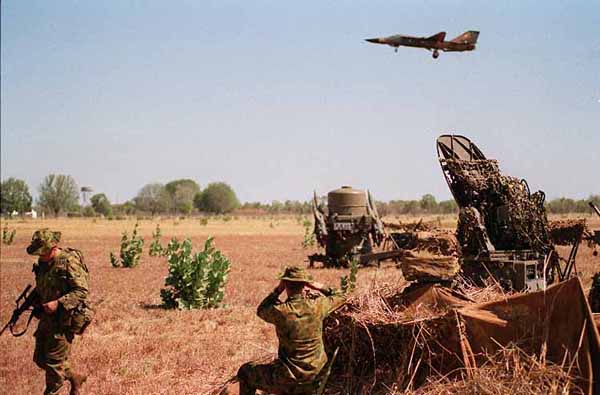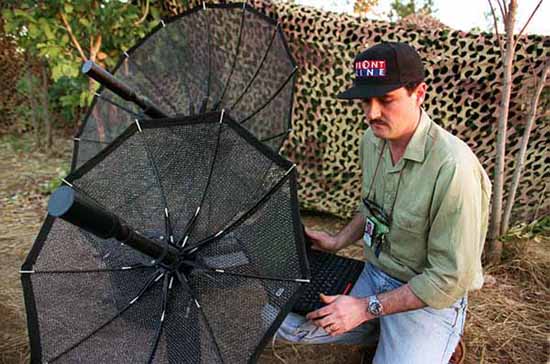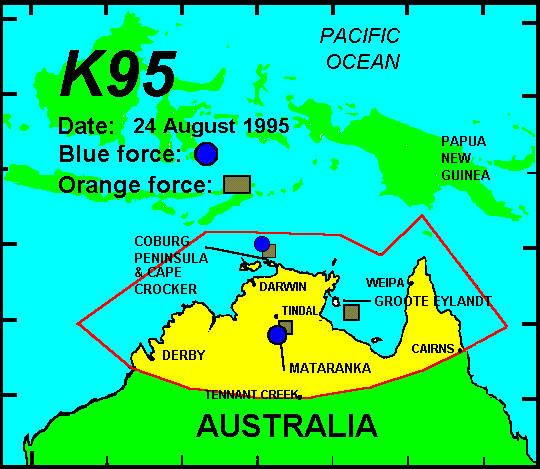In mid 1995 the web was still largely experimental in the Department of Defence. The home page had been running successfully for several months, but we needed to show that Defence was different to the average government agency or commercial company. On a visit to the public relations area, I noticed a pile of press kits for the planned exercise, Kangaroo 95. I suggested this could be put on-line, with reports from the exercise on the web. Following the exercise I received several comments from people at the exercise that they got better reports from the web pages than from internal channels. This lead to the idea discussed later, of using the web for military command and control.
The following was prepared using text and photos from the Exercise Kangaroo 95 Home Page (Defence 1995), and is published with the permission of the Directorate of Public Information, Australian Department of Defence.
 Rapier SAMs & F111 - Photograph by Leading Seaman Robert Fengler, RAN.
Rapier SAMs & F111 - Photograph by Leading Seaman Robert Fengler, RAN.
 Robert Lester and satellite communications
Robert Lester and satellite communications
Exercise area
Exercise K95 took place in an area of over 4 million km square, across the Top End of Australia. It involved over 17,000 Australian Defence Force troops, and visiting units from the USA, Malaysia, Singapore, Papua New Guinea, the UK and Indonesia.
The operational phase of KANGAROO 95 (K95) ran from July to the end of August 1995. It was the longest and most complex exercise ever undertaken by the Australian Defence Force (ADF). As part of the KANGAROO series, the Directorate of Public Relations places personnel in the field to prepare public information on the exercises.
Reports and photographs were transmitted from the exercise area via the Defence data network, augmented by the Australian civil communications network. The reports were received at Defence headquarters in Canberra and up-loaded to a publicly accessible Internet server at the Australian Defence Force Academy.
The first report was issued 29 July. The first photo, of the 16th Air Defence Regiment employing Rapier SAMs, was sent 1 August. The last report, Incidents in the Joint Force Area of Operations, was issued 24 August. Ten reports were issued.
Incidents in the Joint Force Area of Operations - 24 August 1995
2318:00IK AUG95
EXERCISE ONLY
THE FOLLOWING SITREP IS EXERCISE K-95 MATERIAL.
MARITIME
At 17:40 last night, FA-18 fighters destroyed one of two guided missile patrol boats near Smith Point on the Coburg Peninsula after being located by a P3-C maritime patrol aircraft. The PTG was sunk with laser-guided bombs. The two were at anchor in Port Essington when attacked. They had been harassing and sinking merchant vessels in the Darwin approaches. The second PTG escaped.At 07:17 today, an unidentified PTG stopped and boarded a merchant ship, the Lady Jan 40 km north west of Cape Crocker. About 09:40 the barge Glenda Lee was fired on by fast-moving Wellins class PTG five Nm north of Crocker Island.
At 09:10 this morning, another PTG ROS Sebanjur was attacked by a Blue Force P3-C maritime patrol aircraft 10 Nm north of Port Essington with a Harpoon missile. The PTG escaped significant damage and retaliated with a stinger missile, downing the P3-C.
TINDAL
Late this morning, two Elliot fighters were destroyed by Rapier missiles after a raid on Tindal. The raid resulted in the destruction of a Kiowa helicopter, two FA-18s, a number of vehicles (11 fuel tankers and an airfield sweeper) and the fuel distribution point and one person killed.The raid may have been aimed at reducing the danger of attack during an enemy extraction of Mataranka.
MATARANKA
Indications are that the enemy forces there are not moving too far from the airfield and may be considering a quick withdrawal after making a gesture following the serious setbacks of the past few weeks. The apparent lack of resupply arrangements for the troops there could indicate the enemy intends remaining only one or two days and husbanding limited aircraft to ensure a successful air extraction.Blue Forces received reports last night that Orangelanders have set up a prisoner of war holding area in Mataranka. There is a possibility the POW may be used as a bargaining chip for Orange Force extraction from the area.
TINDAL/GROOTE EYLANDT
Minor harassment has occurred around Tindal and on Groote Eylandt. One of two Orangeland soldiers who fired on an aircraft at Groote Eylandt was killed when engaged by 2RAR soldiers late yesterday, while two Orangelanders escaped after contact with Air Defence Guards at Tindal.
Technology used
The 1st Media Support Unit (1MSU) used two stand-alone portable satellite communications terminals. The larger of the two terminals (at the rear in photo) is capable of 64kbps duplex data, while the smaller of the two uses a digitally compressed signal, operating on a smaller bandwidth. It also has it's own built in rechargeable power supply. Units similar to these have been used by the 1MSU in Somalia and Rwanda.
Commercial off the shelf lap top computers and Internet software were used for transmitting the photos and reports. Photos were processed for efficient on-screen display (640 x 480 pixels, 24 bit colour with de-speckle resulting in a file of under 50Kbytes), but also proved useable for printed reproduction.
I prepared a special K95 Web home page for the exercise, as manager of the Defence home page and while a member of the Commonwealth Internet Reference Group. This is believed to be the first time a military exercise has been reported direct via the Interent.
The home page has background material on the exercise, the daily reports and photos sent by Robert Lester. In addition, there is a link to the daily weather report for the area, from the Bureau of Meteorology and daily satellite image courtesy of the University of Wollongong and James Cook University.
During the exercise the Department of Administrative Services announced K'95 trucking tenders on its Government Electronic Marketplace Service (GEMS). GEMS was linked to the K'95 home page, demonstrating the synergy possible with the Internet.
The K'95 web site had an average of 715 hits per day, during the period of the exercise. The digital photos were downloaded and used by the press, as well as being viewed directly on-screen.
For the first week of the exercise I was officially on holiday, but maintained the K95 home page remotely using a pocket modem and lap top PC from Mallacoota, Victoria.
Discussion Questions
- Try to substantiate the claim that this was the first military exercise reported on the web. Can such claims carry weight, when electronic documents are so easily changed?
- What can you find out from on-line ``open source'' information about the places and people mentioned in this travelogue?
- How has Internet access, by both sides in conflicts, changed the nature of war reporting?
References
Defence (1995) Exercise Kangaroo 95 Home Page, Directorate of Public Information, Australian Department of Defence, Commonwealth Copyright 1995, URL (No Longer On-line)
http://www.adfa.oz.au/DOD/k95r12.html
Further Information
Draft of 29 June 1999 - Comments and Corrections Welcome
Copyright © Tom Worthington 1999 (ISBN 0 909925 77 1 ).
 Map of K95 on 24 August 1995
Map of K95 on 24 August 1995